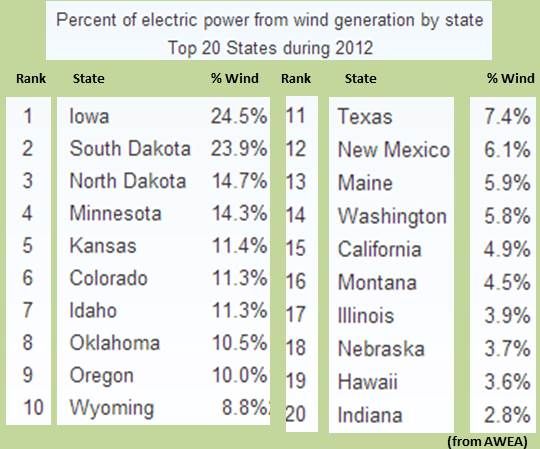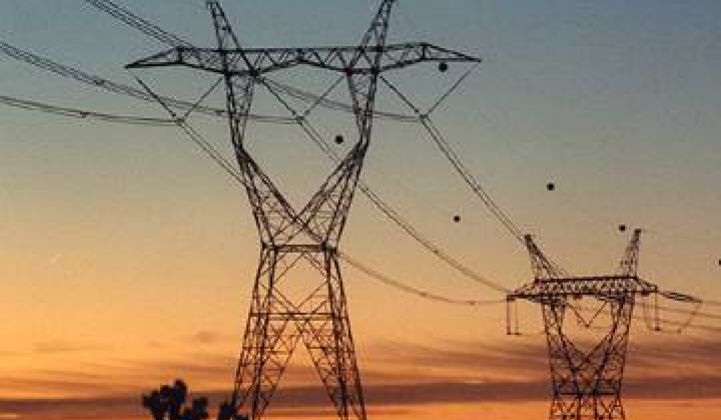The latest numbers on the wind industry show wind energy generating an increasingly significant portion of U.S. electricity.
Wind became, for the first time, the biggest source of new generating capacity in 2012, at 42 percent. That pushed the renewables’ total share of new U.S. generating capacity last year up to over 55 percent, according to American Wind Energy Association (AWEA) industry statistics.
In two states, wind provided almost a quarter of all electricity (Iowa, 24.5 percent, and South Dakota, 23.9 percent, by in-state-generated megawatt-hours). For nine states, wind provided more than 10 percent of the in-state-generated megawatt-hours and, in fourteen states, more than 5 percent.
Because the windiest states are among the less populated, the national number is at 3.5 percent. But that figure is big and growing rapidly in populous places like California, Texas, Minnesota, Colorado and Illinois.
The U.S. wind energy industry leveraged a $25 billion private investment to build a record-breaking 13,124 megawatts in 2012, bringing the nation’s installed capacity to over 60 gigawatts.

A 2010 National Renewable Energy Laboratory (NREL) study reported the U.S. wind resource at over 10 million megawatts, enough to meet the nation's total electricity needs ten times over. In 25 states, the wind potential matches the electricity generation capacity of all their other energy sources.
Many transmission and distribution system operators fear the integration of so much variable renewable capacity threatens the stability of the grid.
The addition of renewables, GTM’s Stephen Lacey reported recently, “will have to abide by one golden rule: reliability. Keeping the lights on is a utility’s core responsibility, and any innovations that threaten that reliability metric simply won’t be allowed onto the grid.”
“Very large quantities of wind are being used by several grid operators with virtually no increase in the need for operating reserves,” AWEA Transmission Policy Manager Michael Goggin. “The Midwest System Operator (MISO) has over twelve gigawatts. The Electric Reliability Council of Texas (ERCOT) has over ten gigawatts. Xcel Energy subsidiary Public Service Company of Colorado (PSCo) has had well over 50 percent wind at times.
Renewables opponents, Goggin recalled, “have said for years that costs would go up and the grid would fall apart. They have been proven wrong.”
In ERCOT’s calculations for 2011, Goggin said, “the total cost for integrating wind came out at about $0.50 per megawatt-hour.” And, he added, without 2011’s anomalies in July and August that accounted for 80 percent of all costs, the total costs in 2012 for the necessary balancing reserves and other expenses associated with the integration of large amounts of wind are expected to be even lower.
“Newer research suggests systems can go to 40 percent renewables with no problem,” Goggin said, “using the very efficient grid operating practices being applied by MISO, ERCOT, the California Independent System Operator (CAISO) and others."
“They do very fast interval dispatch of all energy resources,” Goggin continued. “because load is continuously changing, the output of fossil-fired plants is continuously changing, and, of course, wind is continuously changing, too.” The closer system operators are to real-time dispatch, he explained, the more effectively supply and demand can be balanced without the use of reserves.
“They also have pretty large balancing areas,” Goggin added. “If one wind project is going off, another is probably going on somewhere, providing an overall more stable output. Larger areas also simply have more resources to accommodate variability. In MISO, wind’s variability is just something in the noise. It is not showing up in their reserve needs.”

ERCOT’s data is similar, Goggin said. “The areas of the country that have efficient grid operating practices have shown it is possible to integrate very large quantities of wind very reliably at virtually zero incremental cost. The areas of the country that don’t have efficient grid operating practices, namely, much of the West outside California, are seeing increased costs and challenges.”
Studies show nuclear and large fossil plants actually have “far higher integration costs than renewables,” Goggin said. “Contingency reserves, the super-fast acting energy reserve supply required of grid operators in case a large power plant shuts down unexpectedly, are a major cost. Comparing the incremental cost of wind to those costs that ratepayers have always paid, the wind cost looks even more trivial.”
The fundamental issues are more or less the same with integrating solar, Goggin, who specializes in wind, said. “Relative to wind, solar has more minute-to-minute variability, which increases the cost. But forecasting the sun is easier because it is clear when the sun will come up and go down and when the peak is, and that reduces the cost. But grid operators who use efficient operating methods are finding it is no more of a challenge or cost than wind.”



